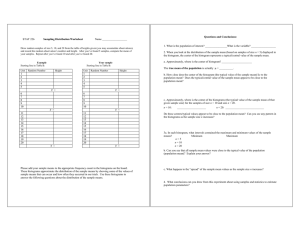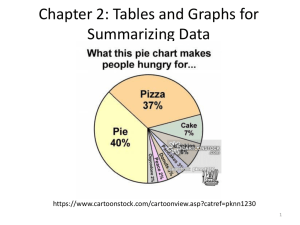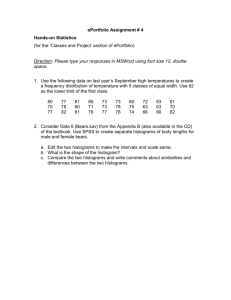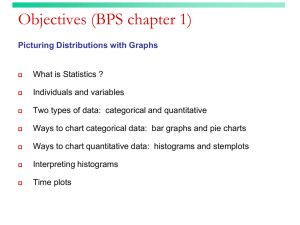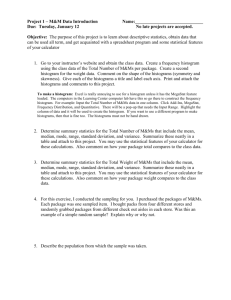Statistics Chapter 2 Exploring Distributions
advertisement
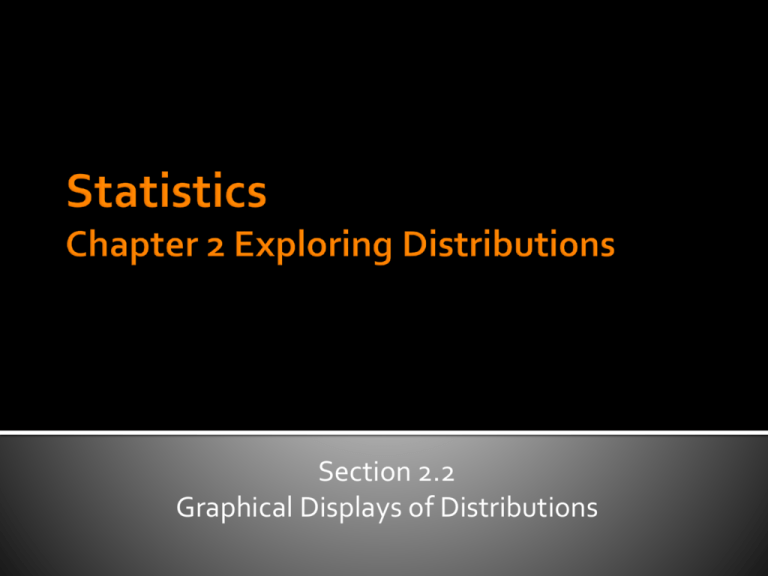
Section 2.2 Graphical Displays of Distributions Dot Plots Histograms: uses bars to show quantity of cases within a range of values Stem-and-leaf or Stemplots: use actual #s to show the quantity of cases within a range Bar Charts: for categorical data Quantitative: counts of how many and measurements of how much Categorical: groups cases into categories Refer to page 43 for table of mammals Gestation, Longevity, Speed are quantitative Wild (Y or N), Predator (Y or N) are categorical Relatively small # of values to plot You want to see individual values You want to see shape of the distribution You want to compare the distribution of a small number of groups • Similar to dot plots in that they show the quantity of data at certain values. • The difference is that the bars show how many data values there are within intervals called bins. Notice that each bin has a width of 5 (Xscale). Refer to page 45 to see some examples regarding characteristics of mammals. What characteristics of the graph do you notice? Do histograms show quantitative data or categorical data? Using your calculator to show a histogram Enter the data for “speed” into L1 in your calc. ▪ Stat, Edit 2nd Stat plot to turn on a plot of a list Select the histogram, L1 Window and set Xmin/max – min to max+ values (0 – 80) Set Ymin/max – 0 to your estimate of the largest frequency Set Xscale – will set the bin sizes (5) Set Yscale – will set scale for frequency along the y-axis (1) Graph ▪ Change the Xscale to 10 - What happens?? To change a Frequency Histogram into a Relative Frequency Histogram: Simply divide the frequency for each bar by the total number of values in the data set. These will now be proportions. Show these proportions of the total on the vertical axis. Now instead of actual frequencies being shown, you have proportions of the total being shown. Frequency Hist. Relative Frequency Notice the vertical (Y-axis): Notice the shapes – they are the same Describe the shape of the distribution, find the median, lower and upper quartiles. You have large number of values to plot You don’t need to see individual values. In other words ranges (bins) are fine You want to see the general shape of the distribution. You can use a calculator or software to create the plots for you. P8 Make histograms of data for average longevity and then max longevity from display 2.24. Compare these distributions using shape, center, spread, gaps, clusters and outliers. Why do these occur? Homework: Create a sentence or word that helps to remember S C S G C O. We will vote on the best and most creative for extra credit. YOU WILL LIVE IN INFAMY!!!! P8 Convert the frequency histograms into relative frequency histograms. P10 Using Rel Freq Hist from 2.28 on p. 47. Estimate the proportion of countries with a life expectancy of less than 50 years. Describe the shape of the distribution Estimate the median of this distribution Page 53 E16, 17, 18, 20, 21 AP add #22


